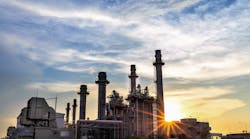Located in a new, state-of-the-art NIST test facility, this specially designed chamber holds samples of pipeline, valve or delivery device materials for testing under pressure to determine their reaction to hydrogen.
Photo courtesy of Burrus/NISTIf hydrogen is ever to play a significant role as a clean, everyday energy source, it will need a safe and reliable distribution system. To pave the way for a hydrogen-fuel infrastructure, researchers at the National Institute of Standards and Technology (NIST) Boulder Labs recently launched the largest hydrogen test facility in the United States for evaluating how component parts of such an infrastructure will react to exposure to this potentially corrosive gas.
Because hydrogen can penetrate and embrittle some metals and alloys, the NIST says developing standards for using existing pipelines, storage tanks, pumps and delivery systems is an essential first step before the elemental gas can be considered as a viable fuel for widespread use.
Tom Siewert leads a group of researchers at this NIST test facility that will be testing these component parts — pipes, valves, fittings and pumps, among other pieces — for their suitability in transporting and delivering hydrogen.
The facility contains one of the largest (at 10 centimeters) internal diameter test chambers in the country. In it are placed standard test specimens of component materials – chunks of pipeline, a piece of a valve – and it is exposed to pressurized hydrogen to measure how it reacts to such an environment and that kind of chemical exposure. With such test data in hand, standards for building a safe, reliable and robust hydrogen fuel system can be developed for future storage, delivery and dispensing.
"You put in specimens to gather the property data, and when it’s pressurized, a shaft goes into the chamber that puts stresses on the specimen to simulate the strains that occur in everyday use," says Siewert, who helped plan the facility. "Structural designers would then put the data we get from these specimens into their models to understand how a structural component would respond to that hydrogen under those conditions."
The test facility is also replete with state-of-the-art safety features, including the ability to run every phase of testing from a remote control center, multiple sensors that automatically shut down the entire system and vent the test building at even the slightest scent of hydrogen gas (1 percent concentration), a massive venting system that is double what code requires, and a lightning detection system that will automatically shut the facility down if a strike occurs within 10 kilometers.
"The quantity of hydrogen in the equipment is low enough that even if all the hydrogen suddenly leaked into the building, it wouldn’t be enough to cause an explosion," said Andy Slifka, a materials research engineer and project leader.
The design of the hydrogen test facility won the RMH Group — a Denver-based mechanical, electrical and industrial process consulting engineering firm — a Gold Hardhat award in 2009 from McGraw-Hill Construction. The award honors the building teams that created the best projects of 2009 as selected by juries of local prominent industry professionals.


